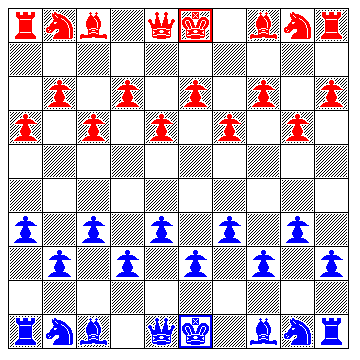
This game, which only came to my attention recently, is of interest for two reasons. One is that sets for this game were manufactured by Drueke, an important American manufacturer of chess sets. Another is that the complement of pieces used in the game is but little changed from that in the conventional game of Chess. Also, the designer of the game, Hudson Maxim, was the brother of Hiram Stevens Maxim, who invented the Maxim gun, one of the earliest forms of automatic weapon, and in his own right invented some forms of high explosive and was involved in the manufacture of smokeless powder.

The pieces are:
A King, with the same move as the King in Chess, and which is represented by the symbol of a chess King in the diagram. However, checkmate is not the object of the game, and thus the King's capture has the same significance as that of any other piece. Also, there is no Castling.
A General, with the same move as the Queen in Chess.
Two Mortars, with the same move as the Rook in Chess.
Two Horses, with the same move as the Knight in Chess.
Two Cannons, with the same move as the Bishop in Chess.
Two Flying Machines, not shown in the diagram. Each Flying Machine, starting from outside the board (sets for the game have them stationed on circles immediately behind the two vacant squares on the back rank) can be moved only once during a game. Its move consists of being placed on any vacant square of the board, other than the starting squares of the two Kings, which is then permanently blocked.
Ten Troops. The five Troops that are further advanced are called Van Troops, with the other five called Rear Troops, and their pieces are different in appearance, but the moves of all ten are identical. The Troops, represented by the symbol of a chess Pawn in the diagram, may make the same moves as a Pawn in chess, but a Troop can also jump over an enemy Troop in a diagonally forwards direction, but not over any other piece.
Captures of an enemy Troop by jumping are subject to a compulsory capture rule. If such a capture is available, the enemy Troop may be taken instead by conventional Pawn capture by displacement, or, if possible, it may be taken by another piece. If, however, it is taken by jumping, then the series of jumps must continue until no further Troop captures are available in the particular path taken (there is no obligation to capture the maximum possible number of Troops, the rule being modeled on that in the British and American game of checkers or draughts).
The Troop may make a double step move forwards as its first move, as the Pawn in Chess, but the book describing the rules of this game makes no mention of any form of en passant capture being available as a result of this. (By analogy with the other rules for the movement of Troops, however, it might be supposed that en passant capture is allowed, but only by displacement and not by jumping.)
The object of the game is to place one of one's pieces on the starting square of the opponent's King, and not have it captured on the opponent's turn immediately following.
There is no Castling. Also, there is no Pawn promotion; a Troop simply remains permanently immobile once it reaches the last rank. Except for a Troop in the enemy Citadel, the starting space of the enemy King, Troops on the final rank are immune to capture.